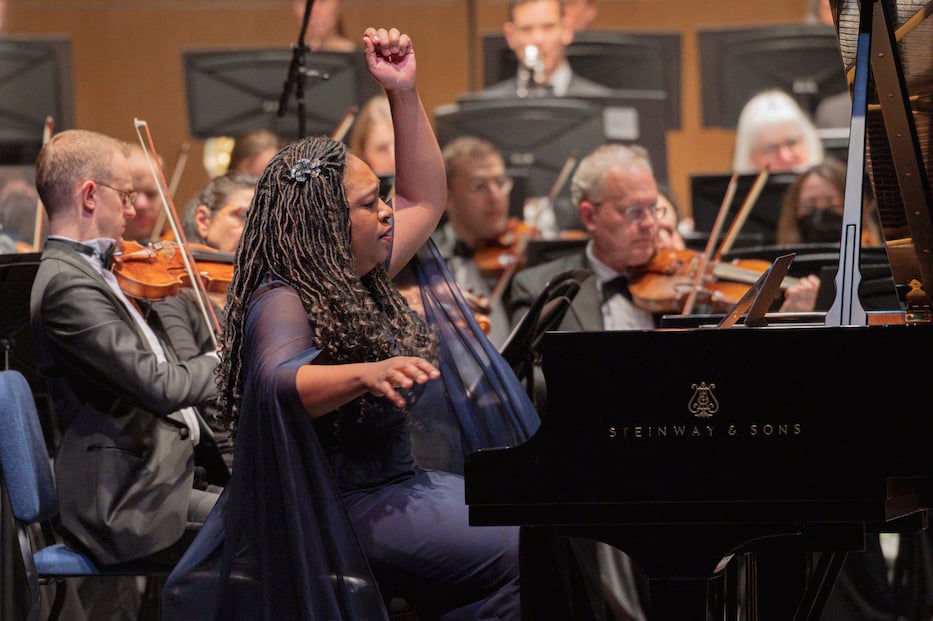
Culture & Community | Music | Southern Connecticut State University | Arts & Culture | Music Haven | New Haven Symphony Orchestra | Arts & Anti-racism
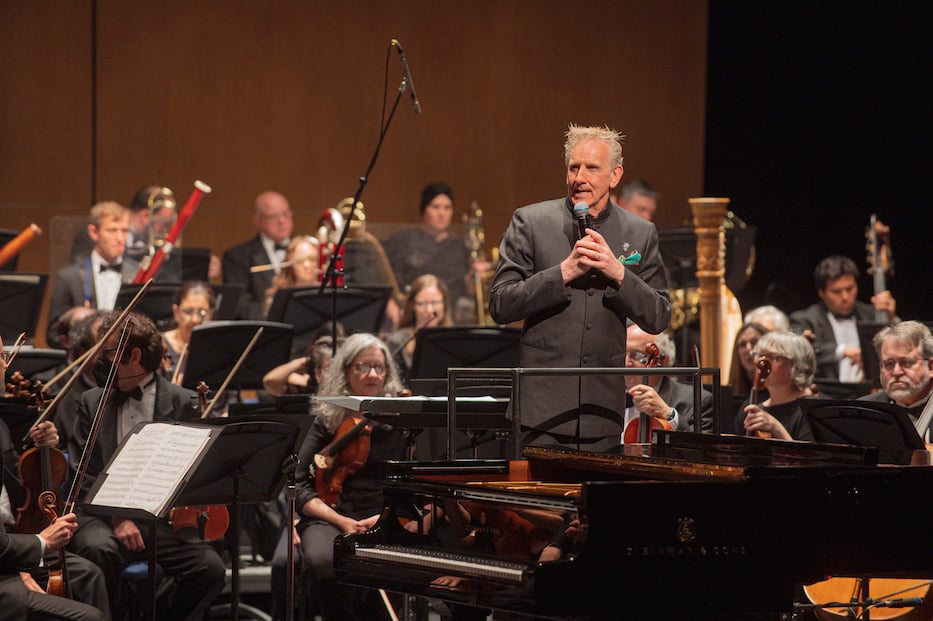
Matt Fried Photos courtesy of the New Haven Symphony Orchestra.
It was the woodblock that made the audience suddenly feel on edge, as strains of "I Want Jesus To Walk With Me" swelled over the room. The sound ticked past the stage and into the house, quickening as if someone had lit a fuse in the percussion section. The bass drums rolled in underneath; symbols crashed violently. The sound crested, then fell eerily silent.
In an instant, musicians had cleaved time and space in two. In one world, they were still in New Haven, dressed in coattails and suit jackets and long black skirts, hands hovering over their instruments. In the other, it was September 1963, and a blast had ripped through the Sixteenth Street Baptist Church, killing four little girls because they were Black. In the audience, a listener could have heard a pin drop.
It was one of several astounding moments last Friday night, as the New Haven Symphony Orchestra (NHSO) presented its final concert of the season at the John Lyman Center for the Performing Arts at Southern Connecticut State University. Over two hours, it featured the work of composers Margaret Bonds, Helen Hagan, Florence Price and Quinn Mason—all Black artists whose sonic influences range from African American spirituals, juba and jazz to Antonín Dvořák and Igor Stravinsky.
With Grammy-winning pianist Michelle Cann, it also marked the premiere of Helen Hagan's 1912 Piano Concerto No. 1, Mvt. 1, orchestrated by Dante Anzolini. From its first note to a final standing ovation, it doubled as a triumphant celebration of Black voices and Black futures, blazing a clear and bright path forward for the organization and for classical music in New Haven.
As Maestro Alasdair Neale returned to the podium after months away, it was also a reminder that any incoming music director has enormous shoes to fill.
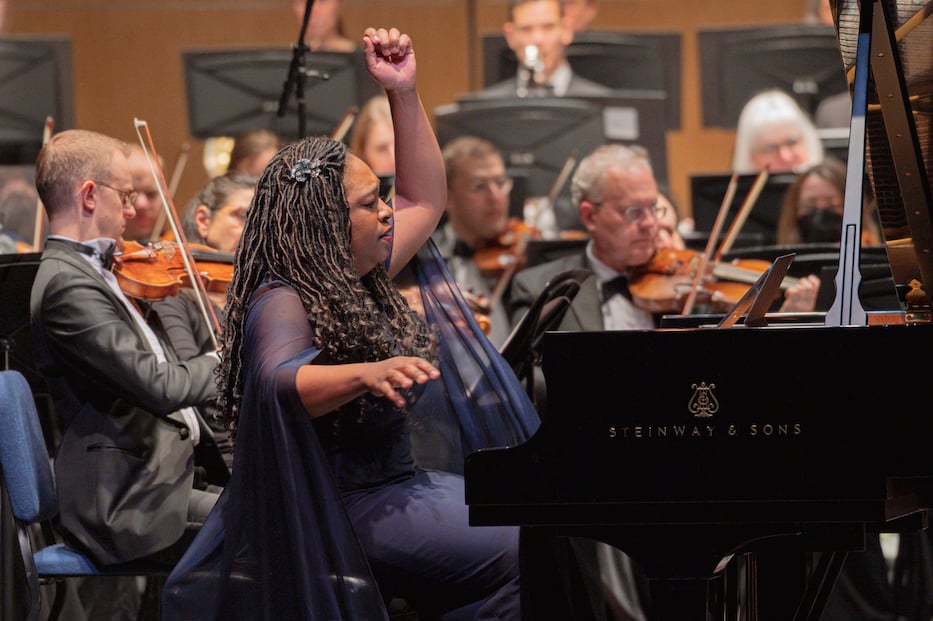
Michelle Cann. Matt Fried Photos courtesy of the New Haven Symphony Orchestra.
"[These are] three remarkable Black women, trailblazers very much in their own right," Neale said of Hagan, Bonds and Price at the top of the concert, beaming as he introduced the first work of the evening. "The music of Margaret Bonds, Helen Hagan and Florence Price ... we are in for three real treats there."
It was, if such a thing is possible from a maestro who can and often does go airborne while conducting, an understatement. When Bonds' Montgomery Variations began, it was not a classical convention that grabbed a listener, but the bone-deep strains of "I Want Jesus To Walk With Me,” a spiritual that reminds its listener of Christ's constancy and goodness in the depths of suffering. Where words might otherwise have been, the audience heard Bonds’ rising, harmonious strings and soulful horns, fierce and certain but never bombastic.
There’s a thrilling, deeply affecting treatment of the source text there. When an oboe warbled at the top of her second movement ("Prayer Meeting"), it sounded like a gentle human voice, reminding others in the room of chapter and verse, of what was once at stake in the Jim Crow South. When it picked up later in the same movement, the audience could feel it marching in time with the music, the footfalls clear and steady as horns stuck their landing.
The work is steeped in history: Bonds wrote Montgomery Variations in 1964, in response to the Montgomery Bus Boycott, the March on Washington and the horrific, white nationalist bombing of the Sixteenth Street Baptist Church in Birmingham, Alabama in September 1963. The attack killed four Black girls—Addie Mae Collins, Denise McNair, Carole Robertson, and Cynthia Wesley—and left over 20 people injured.
"It's one of the most brutal and obscene episodes in the civil rights struggle, and it's cataloged here by Margaret Bonds with incredible power and potency," Neale said Friday. "Out of that shocked abyss, there emerges a wonderfully simple and stark lament."
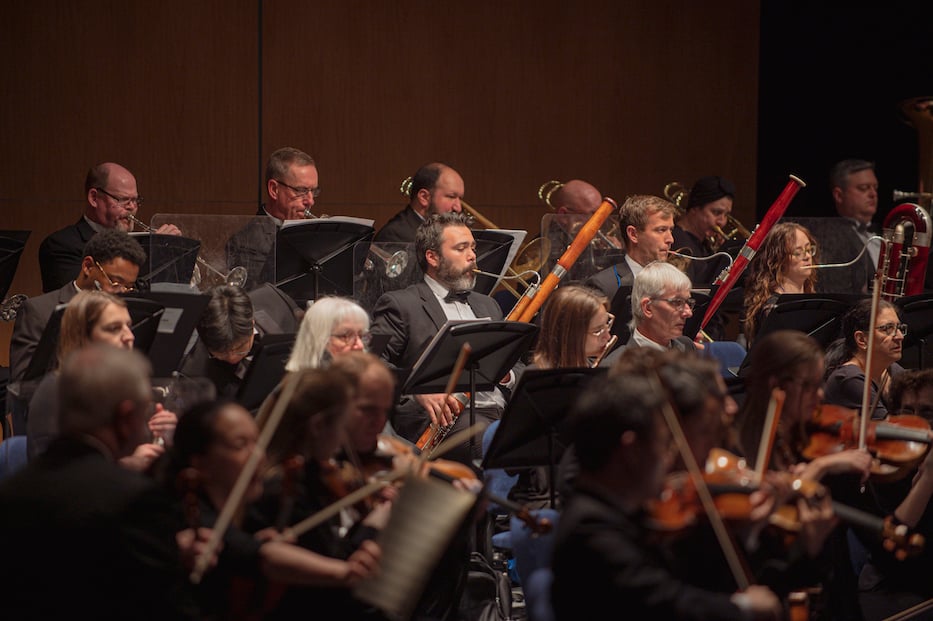
Matt Fried Photos courtesy of the New Haven Symphony Orchestra.
Friday, listeners could hear that in real time, as Bonds telegraphed the destruction of the bombing (and indeed, of white supremacy that continues in this country today) with angry, irritated percussion, crashing cymbals and drums that frothed and undulated before going quiet just as quickly. When Neale brought musicians to their final note, one arm soaring before it came in close and gentle, attendees sprang up from their seats, some bursting into applause. A few wiped tears away from their faces.
No wonder, then, that it laid the groundwork for Hagan's piano concerto, written when the composer was just 19 years old and still living in New Haven. Over a century ago, it was first performed in Woolsey Hall with the New Haven Symphony Orchestra in 1912. When Anzolini began reconstructing the work, he was working from a piano duet version of the first movement, the only part of the work to survive over a century later.
As Cann took a seat at the piano Friday, it was the certainty and vigor of her touch that defined the piece’s premiere in New Haven. She took a breath in, and it was as if the piano was breathing with her. She leaned over the keyboard, her shoulders rolling forward, and bore down until the sound soaked the space, rushing out to the aisles and into the furthest of back rows.
Within seconds, she and the instrument were extensions of each other, her fingers at their most natural as they flew across and thrummed with energy. At one moment, the music around her parted, and it was as if it was just Cann and the piano on stage. At another, she let the orchestra rise around her, the keys holding their own as horns, woodwinns and percussiom joined the mix. In the audience, Anzolini watched, spellbound, as his orchestration came to life.
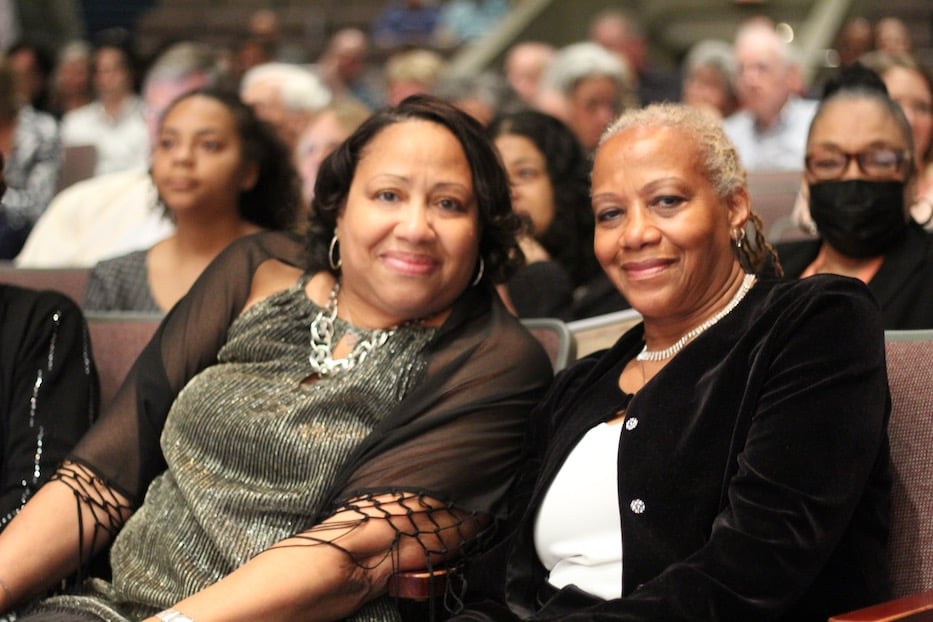
Rosalind Estelle Lawrence and Valerie Eugenia Rooks. Lucy Gellman Photo.
He wasn’t the only one. In the front row, Valerie Eugenia Rooks and Rosalind Estelle Lawrence sat, stunned into an emotional near-silence by the end of the work. The grand-nieces of Helen Hagan, Rooks later said that the moment left her awestruck and emotionally overwhelmed at the same time. Both she and Lawrence made the trip from North Carolina to New Haven to see the performance.
“Just to be here watching Michelle play, it was like she knew my aunt,” Rooks said. “My aunt played like that. It’s beautiful that they created this program in this way because their work [Price, Bonds and Hagan] should flow off our mouths just like Beethoven, Bach and Mozart.”
“It’s just great that they are bringing to life their music,” she added.
“If You’re Playing Black Music, You’re Playing History”
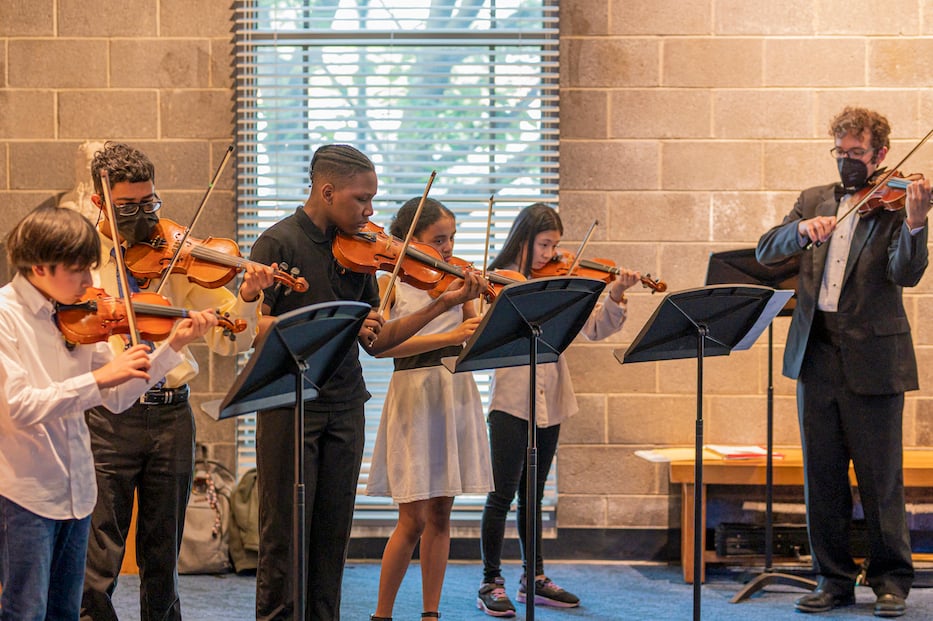
Some of the students in Gregory Tomkins' violin studio. Matt Fried Photos courtesy of the New Haven Symphony Orchestra.
In many ways, that conversation began well before musicians ever took the stage, and lasted after the final note of Mason's A Joyous Trilogy hovered over the audience. In the weeks leading up to the concert, the NHSO held several events celebrating Hagan, the first known Black woman to graduate from the Yale School of Music, and most likely from Yale itself.
In early May, soprano Lisa Williamson spoke at the Stetson Branch Library on the history and legacy of Price, Bonds, and Hagan, as string musicians Tiffany Wee, Marika Basagoitia, Jennifer Quián-López, Rebecca Patterson performed Price’s String Quartet No. 2.
Then that weekend, a celebration of Hagan's life and work came to the Edgewood Avenue oasis BLOOM and the Dixwell United Church of Christ, where she was once the organist and music director. Friday, Dixwell UCC members dotted the crowd, and listened as Cann took them to an entirely different spiritual plane.
That sense of excitement buzzed and hummed through the Lyman Center well before ushers ever directed the audience toward the auditorium. In the building's lobby, a handful of students from the nonprofit Music Haven dipped into variations on "Twinkle Twinkle Little Star," moving into Kenneth Kafui’s “Mele Sue” as they warmed up and got comfortable.
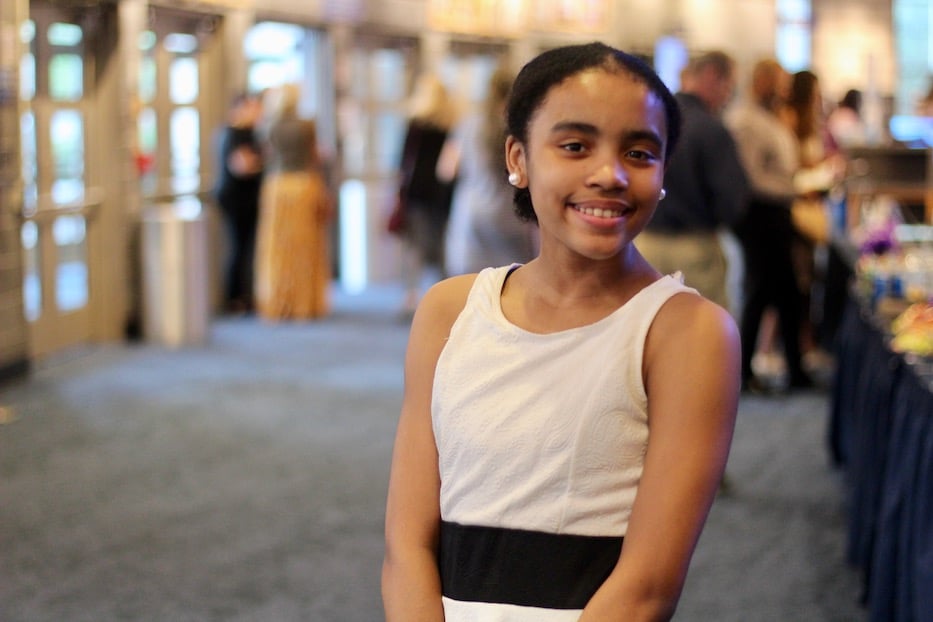
Maegiani Davenport. Lucy Gellman Photo.
As young soloists rotated in and out, they stood before a growing audience of parents, fellow students and symphony goers, including NHSO Board President Dr. Keith Churchwell. One moment, and Maegiani Davenport was leading the group in a sweet and delicate, loping “Andantino.” Another, and Ashley Chan was deep in a duet with instructor Gregory Tomkins, who was due onstage in less than 30 minutes.
For many of them, it marked the chance to reflect on the meaning of Black artists and composers, including those who have graced their Erector Square space in recent months. In October, NHSO composer-in-residence Joel Thompson visited students at the organization, teaching a master class before both the NHSO and the Haven String Quartet programmed his work within weeks of each other.
As he packed up his violin after the performance, seventh grader Kevin Witherspoon noted how uncommon it still is to hear a full program of Black composers, let alone three Black women. A student at Wexler-Grant Community School, he listens to Black musicians semi-religiously at home, with favorites that include Michael Jackson, James Brown, Whitney Houston and vintage Janet Jackson.
But when he steps into spaces dedicated to classical music, he said, he rarely expects to play or hear them. If he were invited to a program like Friday's, he said, "I'm joining! I'm definitely joining!" He pointed to the importance of giving Black artists their proper due, of which they have often been historically robbed.
“If you’re playing Black music, you’re playing history,” he said. “Like, basically for all Black people, but also for all Americans. In my opinion, it’s good that they’re doing it. They’re telling us about history.”
Violinist Maegiani Davenport, a sixth grader at Betsy Ross Arts Magnet School (BRAMS), said that the pre-show performance “felt kind of nice,” particularly as attendees stopped to listen to Music Haven for a few moments. “When I have a solo, I feel powerful,” she said—and was excited to share her work with listeners who might not otherwise hear it.
Not long after learning about the composers on Friday’s program, she slipped into the audience with her mom and little brother, listening at the edge of her seat for much of the concert. For her, it’s part of an education that also includes bopping out to Beyoncé (“Halo” is her favorite) and listening to her older sister practice Bach. She likes having the balance of both, she said—and thinks that symphonies could too.
“I think it’s very thoughtful that they’re making them visible,” she said.
A Joyous Trilogy, & A Joyous Second Half
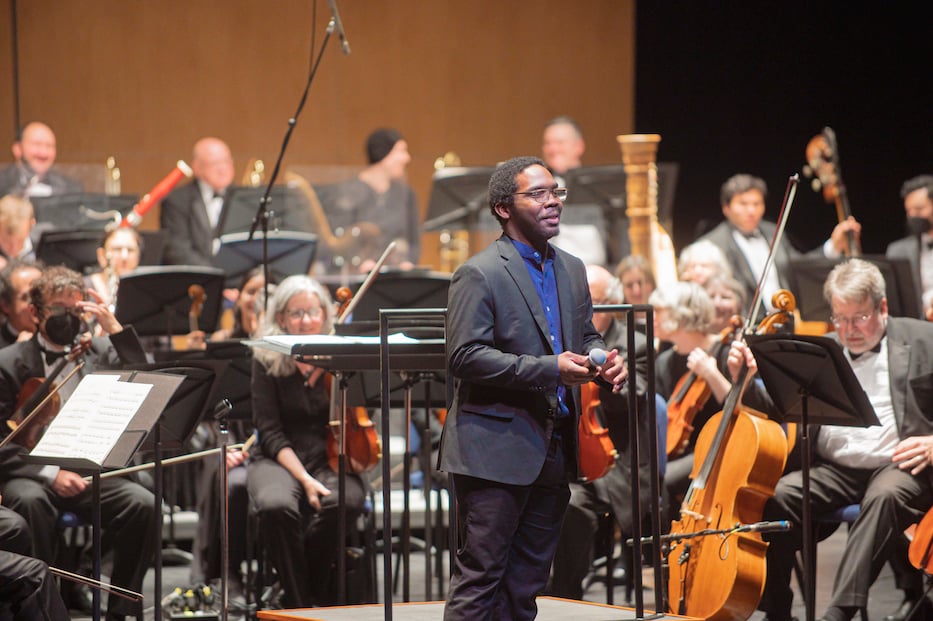
Quinn Mason. Matt Fried Photos courtesy of the New Haven Symphony Orchestra.
Back in the auditorium after intermission, Cann glided through Price’s Piano Concerto in One Movement, the same piece for which she was awarded a Grammy earlier this year. In the work, a listener can hear the breadth of Price’s inspiration, from Franz Liszt to juba and ragtime. As it began, Cann played the symphony in, guiding them until she suddenly reined it in, and instruments came charging forward.
As they bloomed over the stage, Cann pulled back for a moment, and then came back in, this time playing so gently it seemed that the piano was stitched right into the piece. She picked up the tempo, and the instruments went with her. She pulled back, and initiated a a stunning, still-startling call-and-response with the woodwinds and later the strings.
It made for a thrilling final section (while the piece is one movement, it does have three distinct sections), as she led the orchestra in an ode to ragtime that brought it back to the early 20th century. At the end of the piece, she threw her hands into the air triumphantly as the audience exploded into applause.
Cann hadn’t quite emptied her bag of tricks: she whipped out Hazel Scott’s jazz-kissed, smoldering take on Sergei Rachmaninoff’s Prelude In C Sharp Minor, and left the stage sizzling as she stood for multiple rounds of bows. And then just as quickly, she slipped from the stage into the audience, finding a seat close to the back of the house.
It left the night open to Mason, a Dallas-based wunderkind who is also the 2022-2023 Joyce C. Willis Artist in Residence with the Hartford Symphony Orchestra. Before Neale stepped back up the podium for the piece, he welcomed Mason from the audience to help close out the evening.
“It’s a concerto for orchestra in everything but name,” Mason said, describing the three movements "Running," "Reflection," and "Renewal," that were to follow.
As catering staff uncorked wine bottles and sliced cake out in the lobby, Neale also noted that the piece felt momentous in its own way, as the last one to close out the 2022-2023 season.
He didn’t need to say anything, it turned out: A Joyous Trilogy spoke for itself. Launched with a gentle, not-quite-urgent flurry of woodwinds, the work started at a brisk pace, sound blooming over the audience as it moved forward. Neale’s hands glided through the air, and woodwinds responded so quickly it was, indeed, as if they were running.
In the music, one could hear the early whispers of spring: of crocuses opening, of thick, emerald blades of grass breaking through the frosted ground, of sun-warmed sidewalks after months of wet and gray weather. As musicians moved from “Running” into “Reflection,” they quieted, and something of Bonds’ “Lament” wove itself back through the space.
Then it was Mason breaking back through in time for “Renewal,” as chimes came in around the horns and woodwinds, turning it into a euphoric and sweeping finale.
“It’s been such a pleasure working with them [the New Haven Symphony] this week, with Maestro Alasdair Neale, and everybody’s just been so nice to me here,” he said. “I hope to be back with y’all soon.”
The New Haven Symphony orchestra next performs "Aretha: A Tribute" on June 1 at the Klein Memorial Auditorium in Bridgeport, June 2 the Lyman Center and June 3 at Shelton High School. On June 10, musicians will appear with Angelique Kidjo at 6 p.m. on the New Haven Green as part of the International Festival of Arts & Ideas. More information here.

